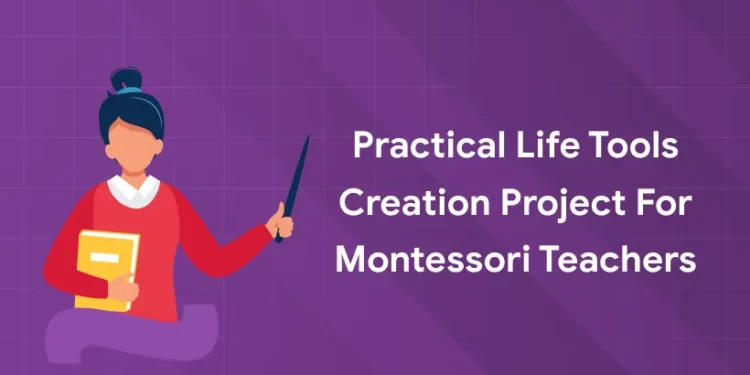Table of Contents
Practical life preparation is a key component of the Montessori method. These exercises consist of motor tasks with real-world objectives that get progressively more difficult. The goal of practical life activities is to help kids become proficient at daily tasks while fostering their independence, self-control, motor coordination, focus, and sense of order. Because of this, practical life tools creation project for Montessori teachers is an important part of the Montessori teachers training syllabus. In this post, we will learn more about Montessori practical life tools and how to create DIY Montessori practical life tools for the final project.
Learn Montessori method principles and practicals from experts! Join the Entri Elevate course!
Practical Life Tools Creation Project for Montessori Teachers: Introduction
Independence is a common objective of all Montessori activities. With each practical life task, a child completes, their sense of independence grows. Children grow more self-sufficient and take pride in finishing tasks on their own as they get used to the activities and no longer need assistance from the teacher. They can soon demonstrate how to complete the tasks for younger kids, which boosts their self-esteem and develops their sense of personal responsibility.
Practical life materials are vital resources for both the home and the Montessori classroom. These resources support the growth of independence, hand-eye coordination, and fine motor skills. Items such as buttons, zippers, tweezers, lacing cards, bowls, pouring jugs, and utensils are examples of practical life materials. Trays, baskets, dustpans, brooms, and mops are some additional frequently used equipment in Montessori classrooms. These resources teach kids about cleanliness, organization, and responsibility. Children in the Montessori setting gain confidence in their skills and a sense of accomplishment as they learn how to use these tools and materials on their own.
Learn how to prepare practical life skills tools for Montessori! Click here to register now!
Types of Practical Life Tools and Their Uses in Montessori Classrooms
1: What is the primary focus of the first plane of development in the Montessori method?
Every practical activity in life has both direct and indirect goals. All the previously mentioned abilities are instances of indirect goals that primarily centre on personal growth. The tangible, quantifiable results are known as direct goals. Through order and repetition, the child can accomplish the various direct aims or goals that Practical Life offers. Some typical practical life activities in a Montessori environment are discussed below. We will also discuss how to turn various Montessori practical life activities into Montessori teacher projects.
Cleaning Materials
A spill can cause a wide range of emotions, including shame, fear, disappointment, sadness, and despair. It can make a big difference to know what to do in a situation that makes you feel anxious. Independence, self-control, focus, and a sense of order are all checked off when a controlled spill is created, the necessary materials are gathered, and the cleanup process is carried out using cleaning supplies. A child, however, won’t notice those. They will feel good about cleaning it up, know how to do it better the next time, and be able to assist a friend. The children like all these direct goals!
You can create a practical life tools creation project for Montessori teachers using this idea. You can create a kid-sized mop or bring some materials and make a DIY mop with the student using some cleaning clothes and a small rod. Or you can prepare a kid-sized rag and bucket.
Dressing Frames
Dressing frames are square wooden frames that are secured together with clothing fasteners and have flaps or pieces of fabric. A child can select from a variety of options, including buttons, snaps, zippers, ties, hooks, and buckles. Children can practice the tasks involved in dressing themselves with the help of the dressing frames. When a child has trouble with a particular item of clothing, usually zipping their coat, these are very helpful. A child can practice and become proficient at zipping both their coat and the frame!
Using this idea, you can make a dressing frame that helps the child practise putting on their clothes.
Spoon and Bowl
Transferring is a kid-friendly activity that only requires two bowls and a spoon! It is structured but offers a lot of options, which is why this activity is so great for kids. The child is shown how to hold a spoon correctly while being given a bowl of rice or beans. They are then instructed to move the beans to the opposite bowl. Although it might seem dull to a child, there are countless options: large scoops or one at a time, the kind of spoon being used, the kinds of materials being used, and the sound of materials hitting the bowl’s bottom. Although the direct goals are impressive, the indirect goals are even more fascinating.
The child learns to move from left to right when spooning materials, which prepares the eye for subsequent tasks like math and reading. Acquiring the correct grip for a spoon will help individuals use silverware during meals and grasp the correct grip for a three-point pencil. Hand-eye coordination is developed through the physical control required to move the spoonful of beans to the other bowl without spilling. The child is also taught to clean up after themselves if materials spill.
In this case, you can prepare a transfer station. You can put one bowl with something in it and the other empty. You can then change the materials in the bowl and record the observations while a child is using the activity station. We can even take this activity up a notch by providing different things in each bowl (sand and salt, sugar and water, sand and water etc.) and asking the child to mix each of the pairs. Then record the child’s reactions and observations they make.
Pouring Station
A tray, two jugs or pitchers of varying sizes, and a cloth or sponge should be used to set up a pouring station. Kids can work on their hand-eye coordination and control by practising pouring water from one container to another.
The tools for this project can be arranged in very different manners. You can arrange the station using utensils of various materials. First, you can keep steel, then you can change it to wood or plastic. Then you can record how differently the child handles the materials depending on whether the material used is natural or synthetic, or how different the design and size of the tools are.
Washing Station
Assemble a sink, water, soap, and a towel at the washing station. Kids can practice handwashing, learn about cleanliness, and wash small items like dishes or toys.
In this case, you can prepare a hand washing/Dishwashing instruction chart to be pasted near the washing station along with preparing the soaps and towels near the sink.
Card Sewing Tools
The Montessori Practical Life lessons heavily emphasize sewing. Children can use sewing as a useful life skill in their everyday lives. Children who learn basic sewing skills develop a sense of independence and resourcefulness by being able to sew buttons, repair clothing, and make basic adjustments. Cut out shapes from cardstock or cardboard, then punch holes around the edges to create sewing cards. Kids can work on their fine motor skills and hand-eye coordination by practising sewing along the holes and threading a needle.
Using this idea, we can prepare a small child-friendly sewing kit containing essential materials like thick yarn punched cards and child-safe needles.
Food Preparation Tools
Engage kids in basic food preparation tasks such as slicing fruits or vegetables, putting butter on bread, or filling bowls with ingredients. Make sure age-appropriate tasks and appropriate safety precautions are in place.
In a practical life tools creation project for Montessori teachers, you can create a mini kitchen using this idea. Arrange a small table with a mini washing station near it. You can put child-safe knives, easily cut fruits and veggies, a towel, a wooden cutting board, spoons and bowls near it. Prepare an activity in which the child (under teachers’ guidance) can make a fruit salad grind some cashews using a small motor and pestle or peel some potatoes using a safe peeler.
Watering Plants Tools
The Montessori method encourages kids to learn responsibility, care, and consistency in their actions when it comes to watering plants.
You can create a watering tool kit that contains a watering can, a tray and a small cloth to clean up in case of spills.
Flower Arrangement Tools
Give kids a range of flowers, gardening tools, and vases. They can take care of plants, trim stems, and arrange flowers while learning about responsibility, nature, and aesthetics.
If you select this idea for your project, then you can prepare a flower arrangement kit as your practical life tools creation project for Montessori teachers. You can make a woven basket and ask children to collect flowers from the Montessori Garden. Then use the vase and other cutting tools to prepare the flower arrangement and help them select a spot for each of their arrangement in the classroom.
Cleaning Tools
Make kid-sized cleaning supplies, such as a miniature mop, dustpan, broom, or spray bottle. Youngsters can help with cleaning tasks, encouraging accountability and honing practical skills.
As with any Montessori project, keep in mind to assist the child in finishing the entire work cycle, from setting up to putting away materials. To keep the child interested, play some entertaining clean-up songs.
All you have to do is prepare a kid-sized cleaning cady with kids-sized cleaning clothes and child-safe products. It will help the children learn about which cleaning item goes where and how to clean them and store them properly after each use.
Transferring and Sorting Containers
Use small containers and objects like beans, buttons, or beads to set up activities involving sorting and transferring. Sorting, scooping, pouring, and transferring objects helps kids focus and improve their hand-eye coordination.
Here, you can prepare a set of toy boxes for separate types of toys. Then ask the children during the clean-up activity to differentiate the toys according to certain criteria and put them in assigned boxes.
Table Setting Apparatus
Arrange a tray with plates, cups, cutlery, and a placemat. Kids can practice mealtime table manners, mealtime routine independence, and table setting.
Here too you can prepare a chart with instructions and pictures on how to set a table properly according to the occasion.
| Also Read | |
| Montessori Learning Materials | |
| Montessori Pink Tower Making | |
| Knobbed Cylinders in Montessori | |
| Montessori Red Rods |
Garden Tools
Give kids gardening equipment that is appropriate for their size, such as a watering can, rake, and tiny shovel. Through gardening activities, kids can learn about nature, plants, and environmental responsibility.
There are lots of possibilities when it comes to selecting gardening as a practical life tools creation project for Montessori teachers. You can make gardening tools appropriate for children with additional new and creative safety features.
Get the best PDF notes to learn Montessori principles! Register to join Entri Elevate now!
Get Certified & Start Your Montessori Career
Montessori Teacher Training Course by Entri App: Gain expert skills, earn certification, and kickstart your teaching career.
Join Now!Tools and Resources Needed to Create Practical Life Tools
Some tools and resources are essential for creating models for practical life tools creation projects for Montessori teachers. Some of them are listed below.
- Small cleaning clothes
- Small hand towels
- Safety scissors
- Safe kitchen tools
- Rods with rounded edges
- Kids table
- See-through vase made of safe materials
- Everyday things.
- Gloves
- Water taps for kids
Learn from the best in the field! Join Entri Elevate Montessori teachers training course!
Documenting and Presenting Your Practical Life Tools Project
Project documentation is the methodical and precise recording of significant project details. The collection of all documents created during the project process that are related to the project is known as project documentation. Understanding the purpose of such a report and who will read it should be your priority. The format provided here should be followed when recording the practical life tools creation project for Montessori teachers. The document should have a title page, abstract, acknowledgement page, and introduction in the first part. The next part should contain a literature review, design, requirements etc. The third part should have the implementation and recording of observations and evaluation. The last part should be the conclusion of the project.
The idea might still not be clear to some. There is no need to be tense. Having a good mentor can clear all the doubts and tensions. And where can we find good mentors? Have you heard about the Entri Elevate Montessori teacher’s training course? They provide Expert Faculty Guidance for the whole of their course.
Unsure about your career? Join Entri Elevate Montessori teachers training! Find the best placements!
Practical Life Tools Creation Project for Montessori Teachers: Conclusion
Activities from everyday life are a crucial part of Montessori education. A child’s independence, focus, coordination, and sense of responsibility are all developed through these activities. Kids gain confidence as they acquire important life skills like pouring, spooning, washing, and dressing themselves. Therefore, practical life tools creation project for Montessori teachers is an unavoidable part of training. Use the information given in this blog along with your innovative ideas to create the best practical life tools creation project for Montessori teachers.
Get Certified & Start Your Montessori Career
Montessori Teacher Training Course by Entri App: Gain expert skills, earn certification, and kickstart your teaching career.
Join Now!Frequently Asked Questions
Why is practical life skills training an essential part of Montessori?
Providing your kids with Montessori DIY Practical Life activities is a fantastic way to help them develop their independence, confidence, and motor skills. Children can acquire the self-control, problem-solving skills, grace, and courtesy that are essential components of the Montessori method with the help of parents or teachers.
How to carry out a watering plants activity with Montessori children?
This is how you can help the children participate in watering plants activity.
Getting Ready
Assemble the required supplies, such as a tray or basin to catch any extra water, a small pitcher or jug, and a watering can.
Observe
Invite the child to look at the plants and determine how often they need to be watered. Explain the significance of giving the plant the proper amount of water for its health and talk about symptoms of dryness, such as drooping leaves or dry soil.
Fill The Watering Can
Accompany the child as they fill the watering can with the proper amount of water. Talk about the significance of finding a balance that will supply adequate moisture without overpowering the plants by not filling the can too full or too low.
Move Carefully
To avoid spills, encourage the child to walk carefully while holding the watering can steadily. Stress the importance of moving carefully and slowly to prevent upsetting other plants or making a mess.
Placement
Help the child place themselves close to the plant that requires watering. To enable a more precise and regulated watering procedure, encourage them to approach the plant’s level.
Pour With Control
Show and assist the child in slowly adding water to the plant’s base, making sure to moisten the soil without over-soaking the leaves. Stress the significance of pouring slowly and carefully to guarantee that the water reaches the roots efficiently.
Observe and Modify
Encourage the child to examine the plant and the surrounding soil after watering, noting any runoff or indications of saturation. Encourage them to take responsibility for keeping the plants in a suitable environment by showing them how to use a cloth or sponge to absorb extra water if necessary.
Cleaning Up
Emphasize to the child the value of tidying up after watering. Help them empty any leftover water from the watering can into a specified container, and make sure they clean the can to get rid of any residue or dirt.











